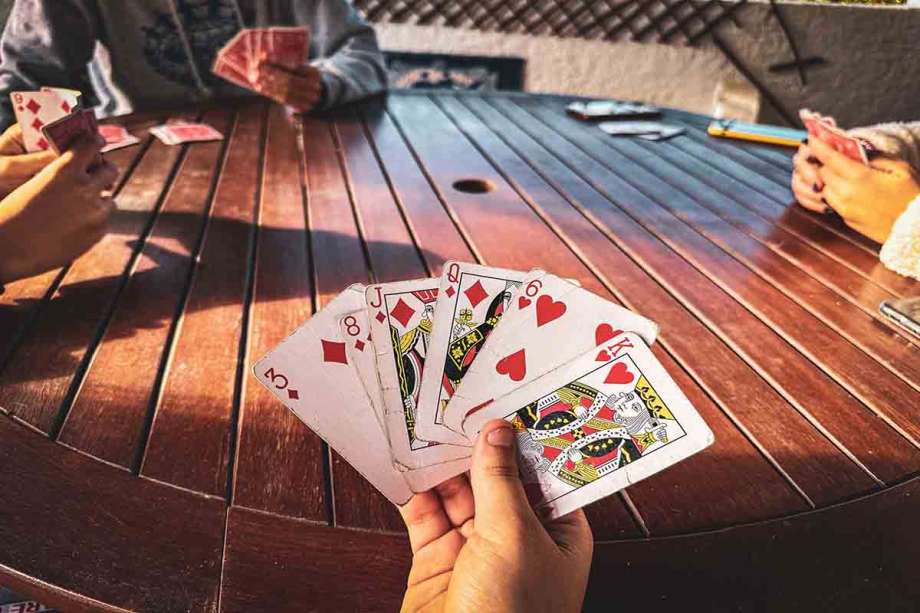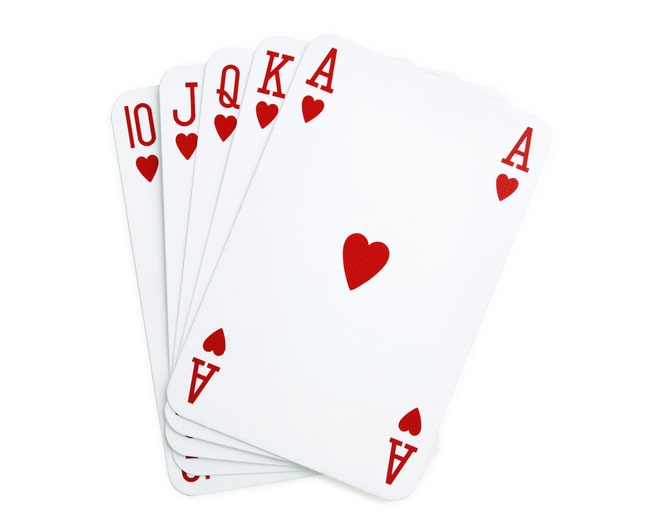How to Play Hearts: Rules for Hearts Card Game

Are you ready to play a game of Hearts?
The card game of Hearts is fun to play anytime with the family. When it comes to playing hearts, you need to know the basics so that you have a better chance of winning family game night!
We’re going to share the rules of Hearts as well as what you need, and of course, the easiest way to play and some little tips. Get your cards ready because it’s game on!
Related: How to Build a House of Cards
What Do You Need to Play the Card Game Hearts?
All you need to play the card game Hearts is a standard 52-card deck.
How Many People Can Play Hearts at One Time?
Hearts can be a 3, 4, 5, 6, or 7-player game. If you have four players, that’s the optimal choice for a game of hearts.
The Object of the Game of Hearts

Hearts is a trick-taking card game where players avoid cards. The person with the lowest score wins at the end of the game. This is why it’s very important to keep an accurate score, especially if you have some highly competitive people playing!
The objective of the game of Hearts is to have the fewest points when one player eventually reaches 100 points.
Players don't want to end up with tricks containing Hearts cards or the Queen of Spades which are worth points. This will rack up a player’s score. But they do want to end up with the Jack of Diamonds.
It may sound a little confusing, but it really does start to make sense after the first round once everyone starts playing.
What is the Ranking of the Different Cards in Hearts?
In each suit of cards, the cards are ranked from highest to lowest with Ace ranked highest and 2 ranked lowest. The ranking order in Hearts from high to low is Ace, K, Q, J, 10, 9, 8, 7, 6, 5, 4, 3, and 2.
How to Play the Game of Hearts
The player to the left of the dealer leads first. (Or the person holding the 2 of Clubs card can start first.) Each player after the lead must follow suit if he can. If he can't, he may play any card he wants.
A player wins a trick when he plays the highest card of the suit that is led. The winner of the trick leads the next.
No player can play a Heart card or the Queen of Spades on the first trick, even if you don’t have any Clubs. A player can't lead with a heart until a heart has been "broken," or played in the game. Breaking hearts happens when a player lacks a card in the suit that has been led, so he throws down a heart instead. Many people play that hearts can't be broken on the first trick.
How to Deal Cards in a Hearts Game
When starting a game of Hearts, each player is dealt the same number of cards. But the number of cards in each hand depends on how many people you have playing.
Typically Hearts is played in groups of 3 or 4 players.
If you have 4 players: Each player receives 13 cards (13 x 4 = 52). The Jokers are excluded from the deck.
If you have 3 players: Deal each player 13 cards, then add the leftover cards to the kitty. The person who takes the first trick will take the kitty, too.
The players cut for deal.
Make sure someone shuffles the deck. Each player is dealt a card until everyone has 13 cards in his hand. The lowest cut is the first to deal. The whole pack is dealt out clockwise, one card at a time, each placed face down.
After the cards have been dealt, each player chooses three cards to pass to an opponent. Players pick their cards after they've looked at them, and before they've received cards from their opponents. Cards are passed to the right at the first deal, to the left with the second, and across with the third. At the fourth deal, players keep their own cards.
Note: After each hand, the deal passes to the player on the dealer's left.
How to Keep Score in Hearts

After all the cards have been played, players count up their tricks. Each player receives a penalty point for each heart card they have. The player who ends up with the Queen of Spades gets 13 points.
Bonus tip: The player who ends up with the Jack of Diamonds gets to subtract 10 points from his score.
Shooting the Moon
However if a player wins all of the penalty cards (13 hearts and the Queen of Spades), that player gets 0 points and all opponents get 26 points. This move is called Shooting the Moon.
The player with the least number of points when any player reaches 50 or 100 points (or another preset score or time limit) wins.
Revoke and Penalties in Hearts
If a player doesn't follow the suit even though he is able, he isn't penalized if he corrects his mistake before the trick is completed.
If a revoke isn't corrected in time and is discovered before the deal has been scored, the "offender" is charged for all the hearts in that deal and no other player receives any penalty points.
Common Rule Variations
While those are all of the basic rules, you may find that some people play Hearts rule variations. You should be aware of these so that you can have the best chances of winning.
Variations of the game Hearts can include:
- Having the player who is dealt the Two of Clubs, or who receives it in a pass, starts each hand, rather than the player who is to the left of the dealer. This player must lead with the Two of Clubs during the first play of their game.
- On the first trick of each hand, no point card may be played.
- The “hole” cards left over after the deck is dealt out to players, other than a total of 4, are given (face down) to whoever takes the first heart.
- After being dealt cards, each player passes three cards of their choice to another player. If it’s a 4-person game, players pass to the player to the left at the start of the first hand, then to the right on the second hand. On the third hand, players across. They refrain from passing on the fourth, then repeat the cycle.
- If a player Shoots the Moon, he can subtract 26 points from his score rather than add 26 points to the other players. This is often done if adding 26 points to everyone else’s scores would put one or more players over the score limit, ending the game and causing the shooter to lose.
- Some play where only 12 cards are dealt to each player. During the deal, four cards are dealt to a face-down kitty. This is added to the tricks of the first player who takes a penalty card. A kitty can also be used to deal with the fact that the cards cannot be dealt evenly when there are more or fewer than four players.
British Version of Hearts
There is also the British version of Hearts, also referred to as Black Maria. In Black Maria, the number of players is usually 3. The Two of Clubs is removed from the pack and 17 cards are dealt to each player.
Black Maria can also be played by four people, in which case all the cards are dealt out. In this variation, cards also pass in the same direction. The player to the dealer’s left leads first and may lead anything with no restrictions.
There are various alternative scoring schemes for this version as well:
- 1 for each heart; 13 for the Queen of Spades
- 1 for each heart; 13 for the Queen of Spades; 10 for the King of Spades; 7 for the Ace of Spades (total 43 points)
- As in Spot Hearts: 2 - 10 of hearts face value; J, Q, K of hearts 10 points; ace of hearts 15 points; Queen of Spades 25 points. If you’re playing this way, the game is played to 500 points, not 100.
What are the Best Cards to Pass in Hearts?

When it comes to passing cards in Hearts, always remember that you don’t want to be holding many high cards at the end of the game. Keeping that in mind, here are some things to consider when passing cards by suit.
Passing Spades
Remember the Queen of Spades is the highest penalty card at 13 points. If you hold that card or the ace or king of spades, you generally want to pass them.
Passing Hearts
Hearts carry a combined 13 penalty points. When it comes to hearts, the Ace, King, and Queen are all good choices to pass. Each one could result in 4 unwanted points or worse.
Passing Clubs and Diamonds
While not as dangerous as the other suits, you still don’t want to be holding the Ace, King, or Queen of Clubs or Diamonds. Look to get rid of these if you can.
Remember, this is a trick-taking game.
What is the Easiest Way to Play Hearts?
When it comes to the easiest way to play hearts, you want to drop a suit as soon as possible. Getting rid of your high cards and points cards and getting rid of a suit early means you can play high and point cards when that suit is played.
Final Tips When Playing Hearts
Keep these tips in mind during gameplay, and hopefully, you'll be victorious!
Pay Attention to What Other Cards People Pass
Whether it’s the first card they’re passing or their last, pay attention to what other people are passing. This tells a lot about a player’s strategy.
If all three cards are the same suit, there’s a good chance your opponent is building a void. If he’s only passing low cards, he may be trying to Shoot the Moon.
Use a High Card if You’re Going to Take a Trick
If you can’t go under, at least throw your highest card of the suit. This gives you a lower chance of taking a trick from the same suit again.
Never Lead With an Ace
Remember to never lead with an ace, especially if the Queen of Spades is still M.I.A. Leading with an Ace pretty much means you will win the trick and all the consequences that come along with it.
It's All Fun and Games!
When it comes to the game of Hearts, remember you always want the lowest score possible. Keep an eye on your opponents’ gameplay to try to determine their strategy. Remember what cards are the best to pass and pay attention to the other cards people are passing. This can help you win the game!
Looking for more fun card games? Check out how to play Crazy Eights or Spades!

